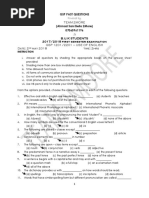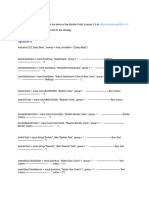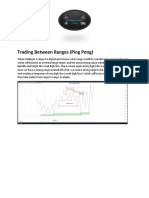Understanding Order Blocks and Fair Value Gaps in
Understanding Order Blocks and Fair Value Gaps in
Uploaded by
simonomuemuCopyright:
Available Formats
Understanding Order Blocks and Fair Value Gaps in
Understanding Order Blocks and Fair Value Gaps in
Uploaded by
simonomuemuCopyright
Available Formats
Share this document
Did you find this document useful?
Is this content inappropriate?
Copyright:
Available Formats
Understanding Order Blocks and Fair Value Gaps in
Understanding Order Blocks and Fair Value Gaps in
Uploaded by
simonomuemuCopyright:
Available Formats
### Understanding Order Blocks and Fair Value Gaps in Trading
**Order Blocks:**
Order blocks are significant areas on a price chart where large financial
institutions (like banks or hedge funds) have placed substantial orders. These
areas represent zones of high interest where the smart money has accumulated or
distributed assets. Recognizing these zones can be critical for traders as they
often act as support or resistance levels in the future.
- **Identification**: Order blocks are usually identified by a period of
consolidation followed by a significant price movement. For example, if there's a
strong bullish movement after a consolidation phase, the consolidation area is
considered a bullish order block. Conversely, a strong bearish movement after
consolidation identifies a bearish order block.
- **Usage**: Traders use order blocks to anticipate where price might reverse or
stall. They place buy orders near bullish order blocks and sell orders near bearish
order blocks, expecting the price to react at these levels due to the presence of
institutional orders.
**Fair Value Gaps (FVGs):**
Fair value gaps are price imbalances created when the market moves rapidly from one
price level to another, leaving a gap in the price action. These gaps occur when
there is an overwhelming imbalance between buyers and sellers.
- **Identification**: An FVG is typically identified on a price chart as a gap
between two price levels that the market did not trade through. This can occur
after major economic announcements, unexpected news, or during high volatility
periods.
- **Usage**: Traders look for these gaps to be filled eventually, as the market
tends to revert to fair value over time. A fair value gap can act as a magnet for
the price, drawing it back to that level before continuing in the original
direction. Traders might place orders to buy or sell when the price returns to the
gap, expecting it to fill.
**Applying Order Blocks and Fair Value Gaps in Trading Strategy:**
1. **Identify Key Levels**: Start by identifying potential order blocks and fair
value gaps on your price chart. Look for consolidation zones and gaps created by
rapid price movements.
2. **Confirm with Volume**: Higher volumes in these zones can confirm the presence
of institutional activity. Look for spikes in volume at the identified order blocks
and gaps.
3. **Plan Entries and Exits**: Use these levels to plan your trades. For order
blocks, place entries near the blocks with stop-losses just beyond them. For fair
value gaps, anticipate the price to fill the gap and plan entries accordingly.
4. **Combine with Other Indicators**: Enhance your strategy by combining order
blocks and fair value gaps with other technical indicators like moving averages,
RSI, or MACD to confirm your trade setups.
5. **Risk Management**: Always manage your risk carefully. Use appropriate position
sizing and stop-loss orders to protect your capital, as these levels are not
foolproof and the market can sometimes behave unpredictably.
By understanding and effectively using order blocks and fair value gaps, traders
can gain insights into market movements and enhance their trading strategies.
You might also like
- ICT Liquidity Sweep and Liquidity Run PDF DownloadDocument5 pagesICT Liquidity Sweep and Liquidity Run PDF Downloadcharleskerama81100% (1)
- ICT Optimal Trade Entry - OTE PDF DownloadDocument4 pagesICT Optimal Trade Entry - OTE PDF Downloadjzhengrong39No ratings yet
- ICT Daily Profiles.Document15 pagesICT Daily Profiles.Cheney ChenNo ratings yet
- Als Trading-1 240209 081846Document47 pagesAls Trading-1 240209 081846EMMANUEL GIOVANNINo ratings yet
- Traderkane - Market StructureDocument16 pagesTraderkane - Market Structurerao muhammad umar farooq100% (1)
- ICT Poi ExplainedDocument2 pagesICT Poi ExplainedsimonomuemuNo ratings yet
- Liquidity SweepsDocument4 pagesLiquidity Sweepschristianjor66No ratings yet
- ICT Mentorship Core Content 1Document35 pagesICT Mentorship Core Content 1hashimahmedx80No ratings yet
- Stoic TradingDocument21 pagesStoic Tradingbruno.m.spyra100% (2)
- BR - UnicornDocument7 pagesBR - UnicornTân NguyễnNo ratings yet
- TRADER 27 - THE GRINDER Rev. 1 1Document10 pagesTRADER 27 - THE GRINDER Rev. 1 1agathfutureNo ratings yet
- GSP 1201 2201 Powered by Team 2more PDFDocument11 pagesGSP 1201 2201 Powered by Team 2more PDFInilazi JimmyNo ratings yet
- DangstratDocument72 pagesDangstratPablo GonzalezNo ratings yet
- Ict Mentorship Core Content - Month 07 My NotesDocument3 pagesIct Mentorship Core Content - Month 07 My NotesPrashantPatilNo ratings yet
- ICT Trading Setup ChecklistDocument3 pagesICT Trading Setup Checklistjonnyjoen4No ratings yet
- True SMCDocument8 pagesTrue SMCseomashal1221No ratings yet
- Order Block PDF by Daytradingrauf FinalDocument7 pagesOrder Block PDF by Daytradingrauf FinalalbertNo ratings yet
- OB SMC CompressDocument21 pagesOB SMC Compressjenzokenny100% (1)
- Fair Value Gap (FVG)Document5 pagesFair Value Gap (FVG)Kanickai DsouzaNo ratings yet
- Inducement TradingDocument14 pagesInducement TradingechewodojusticechigaemezuNo ratings yet
- Candle Range Theory: How To Trade CRT?Document11 pagesCandle Range Theory: How To Trade CRT?habibalimalala3No ratings yet
- A-Z Point of Interest (Poi)Document21 pagesA-Z Point of Interest (Poi)vohuynhan194No ratings yet
- Daily Bias ICTDocument6 pagesDaily Bias ICTrabehajaina.stephen100% (1)
- Order Blocks ForexBy GopalDocument24 pagesOrder Blocks ForexBy Gopalnihalpatil0021No ratings yet
- Sonarlab SMC Guide TranslatedDocument11 pagesSonarlab SMC Guide Translatederfolg.astanaNo ratings yet
- ICT 2024 Mentorship Lecture #7Document3 pagesICT 2024 Mentorship Lecture #7Saravaneshan sakthiNo ratings yet
- Lost Exodus Archives - LiquitiyDocument19 pagesLost Exodus Archives - LiquitiyPariyeksh ChauhanNo ratings yet
- Bullish EngulfingDocument2 pagesBullish EngulfingHammad SaeediNo ratings yet
- Phases of StructureDocument2 pagesPhases of StructureFrom Shark To Whale0% (1)
- ICT Kill ZonesDocument2 pagesICT Kill ZonesliwiuszlipinskiNo ratings yet
- COT High - Low - QuantowerDocument2 pagesCOT High - Low - QuantowermohamedNo ratings yet
- Inner Circle Trader Ict Forex Ict NotesDocument110 pagesInner Circle Trader Ict Forex Ict Notesoratilemoroke893No ratings yet
- Decision Making-Stock TradingDocument17 pagesDecision Making-Stock TradingGayathri BNo ratings yet
- Volume ProfileDocument9 pagesVolume ProfileOscar LinaresNo ratings yet
- Inducement TheoremDocument55 pagesInducement TheoremTUGAS UPRAK100% (1)
- ICT Daily Bias Trick PDF DownloadDocument2 pagesICT Daily Bias Trick PDF Downloadkibetjavan15No ratings yet
- Ollow He Oney (Strategy) : @rankingspa @rankingengDocument64 pagesOllow He Oney (Strategy) : @rankingspa @rankingengageiheri0No ratings yet
- Ict Volume ImbalanceDocument11 pagesIct Volume ImbalanceRicky ChenNo ratings yet
- FVG-IFVG-BPR-VI (1)Document23 pagesFVG-IFVG-BPR-VI (1)kumarpp6001No ratings yet
- PDF Trading Hub 3o - CompressDocument36 pagesPDF Trading Hub 3o - CompressTOUFIK CHIBANENo ratings yet
- Trading Between Ranges (Ping Pong)Document1 pageTrading Between Ranges (Ping Pong)vivekpandey65No ratings yet
- Forex Minion - Mentorship ProgrammeDocument29 pagesForex Minion - Mentorship ProgrammeforexminionsNo ratings yet
- ICT Internal and External Range Liquidity PDF DownloadDocument6 pagesICT Internal and External Range Liquidity PDF DownloadJean-Pierre Crédo LABA100% (1)
- SMC Trade SmartDocument28 pagesSMC Trade SmartOliver GonzalezNo ratings yet
- Liquidity Grabs (Scalpers)Document6 pagesLiquidity Grabs (Scalpers)rnj1230No ratings yet
- CBDR Killzone Bias OTEDocument8 pagesCBDR Killzone Bias OTEKrishnaNo ratings yet
- Thread - On - SMT - Divergence - Thread - by - Dangstrat - Apr 21, 23 - From - RattibhaDocument17 pagesThread - On - SMT - Divergence - Thread - by - Dangstrat - Apr 21, 23 - From - RattibhaJeton AliuNo ratings yet
- Volume ImbalanceDocument1 pageVolume Imbalancekiran visaveNo ratings yet
- Smart Money TrapDocument3 pagesSmart Money TrapKanickai Dsouza100% (2)
- SMC by Jayforex HouseDocument49 pagesSMC by Jayforex Housevoipzr100% (1)
- Double OB With BOS Bounce: Smart Money Concept - SMCDocument8 pagesDouble OB With BOS Bounce: Smart Money Concept - SMCPlay PositionNo ratings yet
- Trading View Chart Colors and Tools Ebook by Trading FanaticDocument17 pagesTrading View Chart Colors and Tools Ebook by Trading FanaticAshish AbhyankarNo ratings yet
- ttDocument26 pagesttSaravaneshan sakthi100% (1)
- How To Refine Order BlockDocument20 pagesHow To Refine Order Blockriteshthakur3690No ratings yet
- Liquidity UniversityDocument70 pagesLiquidity Universitysurisigma25100% (1)
- Fa enDocument24 pagesFa enMBOTAKE LawsonNo ratings yet
- Live SessionDocument5 pagesLive SessionSteve SmithNo ratings yet
- Forex Market Hours: London or Europe SessionsDocument1 pageForex Market Hours: London or Europe SessionssukhenduNo ratings yet
- What Is ForexDocument2 pagesWhat Is ForexsimonomuemuNo ratings yet
- How To Manage ProductsDocument1 pageHow To Manage ProductssimonomuemuNo ratings yet
- Story About Deborah AvwioroDocument1 pageStory About Deborah AvwiorosimonomuemuNo ratings yet
- Deep QuoteDocument1 pageDeep QuotesimonomuemuNo ratings yet
- The Hanging ManDocument1 pageThe Hanging MansimonomuemuNo ratings yet
- What Is A Brokerage Firm?Document2 pagesWhat Is A Brokerage Firm?meifannyshafiraNo ratings yet
- ATR Final Proposal PDFDocument2 pagesATR Final Proposal PDFShanmugamNo ratings yet
- Mas Financ SerDocument37 pagesMas Financ SerPawan ChaturvediNo ratings yet
- Case 2: MSDI - Alcala de Henares, Spain For All Three Questions, Assume The FollowingsDocument2 pagesCase 2: MSDI - Alcala de Henares, Spain For All Three Questions, Assume The FollowingsSammy Dalie Soto BernaolaNo ratings yet
- Session2 Demand v2Document61 pagesSession2 Demand v2Anyone SomeoneNo ratings yet
- DRM CH 2 - Futures Markets and Central Counterparties PDFDocument35 pagesDRM CH 2 - Futures Markets and Central Counterparties PDFNeha SinghNo ratings yet
- Assignment On The Strategic ManagementDocument10 pagesAssignment On The Strategic ManagementBaishali ThapaNo ratings yet
- Chapter 27 Lecture PresentationDocument45 pagesChapter 27 Lecture PresentationSiti AtikahNo ratings yet
- Accounts Receivable and Inventory ManagementDocument5 pagesAccounts Receivable and Inventory ManagementAlextrasza Louise PericonNo ratings yet
- Industrial-Engineering (Set 1)Document24 pagesIndustrial-Engineering (Set 1)Gurmeet SinghNo ratings yet
- China Case Study - Currency ManipulationDocument10 pagesChina Case Study - Currency ManipulationNguyên ThảoNo ratings yet
- SSC CHSL E: Study Material For Quant AptitudeDocument9 pagesSSC CHSL E: Study Material For Quant Aptitudesujitmahabali88No ratings yet
- How To Calculate Yield To MaturityDocument2 pagesHow To Calculate Yield To MaturitySunil KumarNo ratings yet
- CHAPTER 8 PricingDocument24 pagesCHAPTER 8 PricingKatherine MoralesNo ratings yet
- Breakeven Analysis PDFDocument16 pagesBreakeven Analysis PDFTeja VenkatNo ratings yet
- Market StructureDocument20 pagesMarket StructureJan Allyson BiagNo ratings yet
- Percentages##1Document14 pagesPercentages##1zubairNo ratings yet
- Cost of Capital: Dr. A.N. SAHDocument41 pagesCost of Capital: Dr. A.N. SAHHARMANDEEP SINGHNo ratings yet
- PRESENTATION Assignment 8Document2 pagesPRESENTATION Assignment 8Hiếu NguyễnNo ratings yet
- Financial Market and Market StructuresDocument23 pagesFinancial Market and Market StructuresRamil Jr GaciasNo ratings yet
- Derivates: ACCT 320 Spring 2021 Samia AliDocument37 pagesDerivates: ACCT 320 Spring 2021 Samia AliHassanAliNo ratings yet
- Price List Arabic e Robusta Coffee - FevDocument2 pagesPrice List Arabic e Robusta Coffee - FevlhiuahauNo ratings yet
- Fatima M. Chin MBA 2 November 29, 2020 Exercise 3 Driving Industry Competition That Are Affecting The Profitability of This Firm?Document2 pagesFatima M. Chin MBA 2 November 29, 2020 Exercise 3 Driving Industry Competition That Are Affecting The Profitability of This Firm?Fatima ChinNo ratings yet
- Direct Demand FunctionsDocument5 pagesDirect Demand FunctionsLagopNo ratings yet
- saytechiDocument8 pagessaytechizohaibimran023No ratings yet
- Tutorial Solutions6-1Document7 pagesTutorial Solutions6-1Yilin YANGNo ratings yet
- Estimasi InggrisDocument4 pagesEstimasi Inggrisilhamraya885No ratings yet
- File 1Document16 pagesFile 1Ngek NgokNo ratings yet
- Week 8 Tutorial QuestionsDocument4 pagesWeek 8 Tutorial QuestionsShynia ChandNo ratings yet
- IndigoDocument15 pagesIndigoKr RishiNo ratings yet






























































































